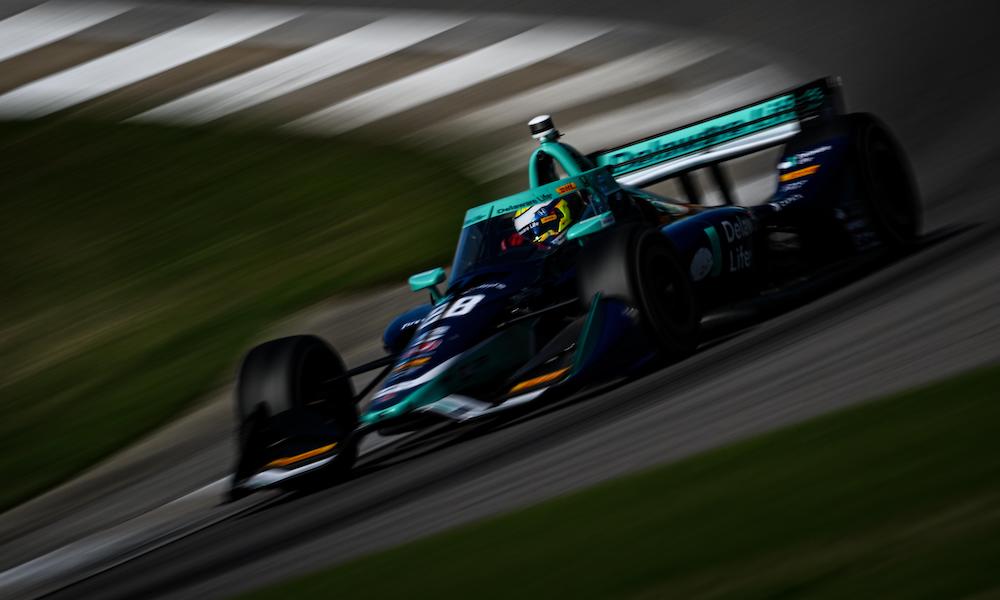All that stands between Romain Grosjean being a five-time race winner and the NTT IndyCar Series’ biggest bridesmaid is 10.1282 seconds.
It was a 4.9510s deficit to race winner Rinus VeeKay at the first Indianapolis Grand Prix in 2021. It was a separation of 1.1142s to Will Power at the second Indy GP that year. It was chasing Josef Newgarden but coming up 1.2869s short last year in Long Beach. The gap shrank on Grosjean’s return to Long Beach last month, but Kyle Kirkwood still managed cross the finish line with a 0.9907s advantage over his teammate. And in the latest installment of the maddening streak that Grosjean wants to end, he was powerless to stop Scott McLaughlin at Barber Motorsports Park and earned yet another second-place result with a 1.7854s difference to the winner.
Combined, Grosjean leads his rivals in the odd category of owning five runner-up finishes without a win.
According to IndyCar statistician Scott Richards, Grosjean isn’t in record-breaking territory at the moment, but he does find himself among an interesting assortment of IndyCar drivers who either wore out the second step on the podium before capturing their first win, or rose as high as that second step before moving away from open-wheel racing.
[lawrence-auto-related count=3 category=1408]
More than 100 years ago, Dave Lewis set the standard for placing second, doing so eight incredible times between 1913-1919, prior to winning his first IndyCar race in July of 1919 at the 1.125-mile board track oval in Uniontown, PA.
Somewhat recent IndyCar veteran Vitor Meira matched Lewis’ tally of eight runner-ups between 2004-2008, but the Brazilian was unable to secure a win before his time in IndyCar was over. Geoff Brabham, father of 2016 Indy 500 starter Matty Brabham, ran second on six occasions between 1981-1987, and like Meira, he never won. The same was true for Russ Snowberger with five trips to second place from 1928-1934 and five for Raul Boesel from 1992-1994, all without the satisfaction of being first at least once in their IndyCar careers.
But there are glimpses of hope for Grosjean in the history books.
IndyCar’s outing to South Carolina in 1954 to race on Darlington’s 1.366-mile oval was an important one for Manny Ayulo, who ended his streak of five runner-ups from 1953-1954 with a win. Former IndyCar badass Pancho Carter also put his string of five second-place finishes from 1974-1978 to rest with his breakthrough victory on the big Michigan oval in 1981. The next stop on the tour at the Indianapolis Motor Speedway road course, site of Grosjean’s first pole position, could easily be the place where the streak ends.
Grosjean led a combined 56 laps during his rookie and sophomore IndyCar seasons. He beat that total in one afternoon by leading 57 laps to dominate most of the Children’s of Alabama Indy GP. The Swiss-born Frenchman has led three of the four races held this year for a total of 90 laps, earning a pair of pole positions and two runner-up finishes for Andretti in the last two weeks.
If there’s anything he’s grown tired of, it’s the number ‘two,’ but it’s a welcome frustration as it signal how close he is to becoming a first-time winner.
“You know, second is not that bad,” Grosjean told RACER. “It could be worse. Racing sometimes does not go your way and at Barber, normally, the two-stop plan wins. But yesterday, it was three stops that won because we didn’t have a yellow and Race Control left the pits open for [those on a three-stop strategy]. Without that, it was a different story. But we’re good. We’ve got two poles; Andretti got three out of four, and we are in a good place in the championship.”
Most people expected Grosjean to have a better season with Andretti Autosport than his first, but few would have predicted his immediate rise to become the fastest and most consistent driver in a squad that includes Colton Herta and Kyle Kirkwood. Presently fifth in the drivers’ standings, Grosjean and the No. 28 Honda entry are looking like the team’s top contender for the title.
“What I see is that we are competitive,” he said. ”And that’s how you win a championship, by being here all the time. So last year was not the case; we had some good ones with bad ones. But this year, I feel like we’re strong everywhere. So for me, winning a championship will mean being here every weekend, and sometimes it comes your way and sometimes it doesn’t come your way, but you are in the mix every single weekend.
“That’s the key to get it. We will keep going, we keep pushing 100 percent. We want to win, but you know, P2 works as well. And if we’re always here, there’s going to be chances that we win. Simple as that.”
